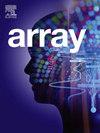Prediction of psychophysiological perception of driver in road tunnel using particle swarm optimization improved stacked denoising autoencoder model
IF 4.5
Q2 COMPUTER SCIENCE, THEORY & METHODS
引用次数: 0
Abstract
Technical limitations of test equipment, changes in test environment, and jerks of test vehicles under the lighting environment of highway tunnels can lead to the appearance of abnormal psychophysiological data, which affects the data quality and the subsequent prediction and analysis. In this study, the physical quantities of lighting environment and the psychophysiological quantities (heart rate, pupil area, recognition distance and reaction time) of drivers were collected, and the information representation of physical quantities affecting the perception ability of psychophysiological quantities were evaluated and screened in terms of importance of variables by correlation analysis method and LASSO-CV regression method. Based on the screened key physical quantities, particle swarm optimization (PSO) was employed to set the hyper-parameters for stacked denoising autoencoder (SDAE), and the prediction results of the PSO-SDAE model were compared with other network methods, and then the partial dependence plot was used to further explore the intrinsic mechanism of information representation for physical quantities. The results show that the proposed PSO-SDAE model can effectively achieves the reasonable configuration of the SDAE network parameters, and clean abnormal data by mining the hidden information and structural features of normal data. The PSO-SDAE model has an excellent prediction accuracy, stability and cleaning effect when facing different scales and types of normal or abnormal data for psychophysiological quantities.

基于粒子群优化改进的叠加去噪自编码器模型的公路隧道驾驶员心理生理感知预测
试验设备的技术限制、试验环境的变化、试验车辆在公路隧道照明环境下的晃动等都会导致心理生理数据出现异常,影响数据质量和后续的预测分析。本研究通过采集驾驶员的照明环境物理量和心理生量值(心率、瞳孔面积、识别距离和反应时间),通过相关分析方法和LASSO-CV回归方法,从变量的重要性角度评价和筛选物理量对心理生量值感知能力的信息表征。在筛选出关键物理量的基础上,采用粒子群算法(PSO)对堆叠去噪自编码器(SDAE)的超参数进行设置,并将PSO-SDAE模型的预测结果与其他网络方法进行比较,然后利用部分依赖图进一步探讨物理量信息表示的内在机制。结果表明,所提出的PSO-SDAE模型能够有效地实现SDAE网络参数的合理配置,并通过挖掘正常数据的隐藏信息和结构特征来清除异常数据。PSO-SDAE模型在面对不同尺度、不同类型的心理生理量正常或异常数据时,具有良好的预测精度、稳定性和清洗效果。
本文章由计算机程序翻译,如有差异,请以英文原文为准。
求助全文
约1分钟内获得全文
求助全文

 求助内容:
求助内容: 应助结果提醒方式:
应助结果提醒方式:


